The White Tea Extract Market is estimated to be valued at USD 1.5 billion in 2025 and is projected to reach USD 2.7 billion by 2035, registering a compound annual growth rate (CAGR) of 6.1% over the forecast period.
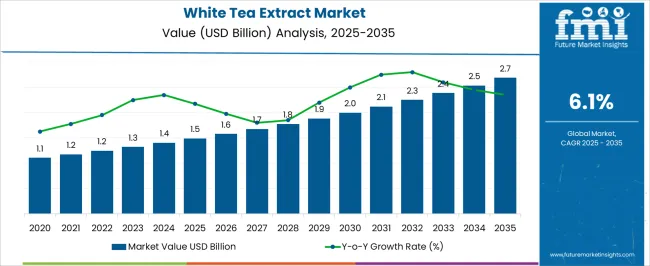
| Metric | Value |
|---|---|
| White Tea Extract Market Estimated Value in (2025 E) | USD 1.5 billion |
| White Tea Extract Market Forecast Value in (2035 F) | USD 2.7 billion |
| Forecast CAGR (2025 to 2035) | 6.1% |
The White Tea Extract market is experiencing steady growth driven by increasing consumer preference for natural, antioxidant-rich ingredients across food and beverage applications. Current trends indicate a strong demand from health-conscious populations in both developed and emerging markets, contributing to higher adoption rates. Growth in functional beverages, bakery products, and nutritional supplements has accelerated the incorporation of white tea extracts due to their perceived health benefits, including antioxidant properties, anti-inflammatory potential, and metabolic support.
The market outlook is shaped by expanding distribution networks, rising product innovation, and growing awareness of clean-label ingredients. Additionally, advancements in extraction techniques have improved the potency and stability of white tea extracts, making them more versatile for use in various formulations.
Increasing investments by manufacturers in research and development to enhance flavor profiles, shelf life, and bioactive compound retention are further supporting market growth As consumer demand for natural and health-focused ingredients continues to rise, the white tea extract market is anticipated to maintain steady expansion with opportunities for new product launches and premium offerings.
The white tea extract market is segmented by application, variety, flavor, and geographic regions. By application, white tea extract market is divided into Food And Beverage Industry, Health And Hygiene Products, Cosmetics, Biological Pesticides, and Animal Feed. In terms of variety, white tea extract market is classified into Darjeeling, White Peony, Monkey Picked, and Silver Needle. Based on flavor, white tea extract market is segmented into Honey, Fruity, Grassy, Vanilla, and Others. Regionally, the white tea extract industry is classified into North America, Latin America, Western Europe, Eastern Europe, Balkan & Baltic Countries, Russia & Belarus, Central Asia, East Asia, South Asia & Pacific, and the Middle East & Africa.
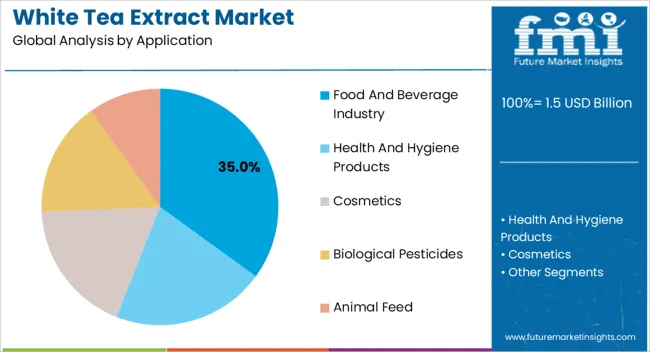
The Food and Beverage Industry segment is projected to hold 35.00% of the White Tea Extract market revenue share in 2025, establishing it as the leading application area. This leadership is being attributed to the rising inclusion of white tea extract in beverages, functional drinks, confectionery, and bakery products due to its antioxidant-rich profile and natural flavor enhancement capabilities. The growth of this segment has been facilitated by increasing consumer preference for products with health benefits, clean-label claims, and natural ingredients.
Manufacturers are increasingly incorporating white tea extract as a functional ingredient to enhance nutritional value while maintaining product appeal. The demand has also been supported by the expanding retail and online distribution channels, enabling broader consumer access.
Additionally, product innovation and versatility of usage in liquid, powdered, and concentrate forms have reinforced the dominance of this segment With rising health awareness and interest in natural, sustainable ingredients, the Food and Beverage Industry segment is expected to continue leading market growth while driving adoption across diverse product categories.
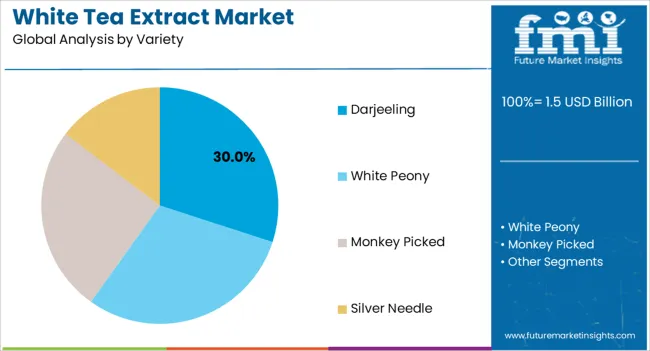
The Darjeeling variety is estimated to hold 30.00% of the White Tea Extract market revenue share in 2025, making it the leading variety segment. Its prominence is being driven by its premium quality, unique aroma, and perceived superior health benefits compared to other varieties. The growth of this segment has been reinforced by increasing consumer willingness to pay for specialty ingredients with traceable origin and consistent quality.
The Darjeeling variety is frequently selected by manufacturers seeking to position products in the high-end and functional beverage categories, where flavor and extract purity are critical. Additionally, its high polyphenol content has strengthened its adoption in health-focused product lines.
Supply chain investments, improved harvesting practices, and standardization in extraction processes have further supported the scalability of this variety As consumers continue to favor high-quality, authentic, and functional ingredients, the Darjeeling variety is expected to maintain its leading position in the market.
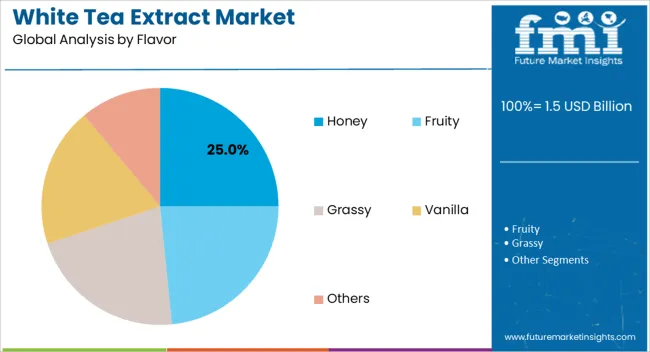
The Honey flavor segment is anticipated to account for 25.00% of the White Tea Extract market revenue share in 2025, establishing it as the dominant flavor preference. This growth is being driven by consumer demand for naturally sweetened and aromatic products, which enhances both palatability and functional appeal. The honey flavor is favored in beverages, confectionery, and nutraceutical applications where natural taste profiles are critical for consumer acceptance.
Its adoption has been supported by increasing health consciousness, as consumers associate honey-flavored extracts with wellness benefits and mild sweetness without artificial additives. Manufacturers have leveraged this flavor to differentiate products, expand market reach, and cater to premium positioning.
Additionally, the compatibility of honey flavor with other natural extracts and functional ingredients has facilitated versatile applications in both traditional and modern food and beverage formats With continued interest in natural and health-promoting flavors, the honey flavor segment is expected to remain a key driver of growth in the white tea extract market.
Young Camellia sinensis plant leaves and buds are used to make white tea extract. The processing needed for white tea extract is less compared to green and black tea extracts. Together with polyphenols, the white tea extract also contains tannins, flavonoids, and fluorides. These extracts provide a variety of benefits, including antibacterial and antioxidant characteristics. They also lower blood pressure, blood lipids, blood sugar, and blood sugar levels while boosting immunity. The market for white tea extract is seeing increased demand as people place more emphasis on eating and drinking healthily.
The leading market players are concentrating on product innovation to give consumers a wide variety of white tea, which might assist increase the market for white tea extract, as a result of the rising consumer demand for tastes and textures.
In our new study, ESOMAR-certified market research and consulting firm Future Market Insights (FMI) offers insights into key factors driving demand for White Tea Extract.
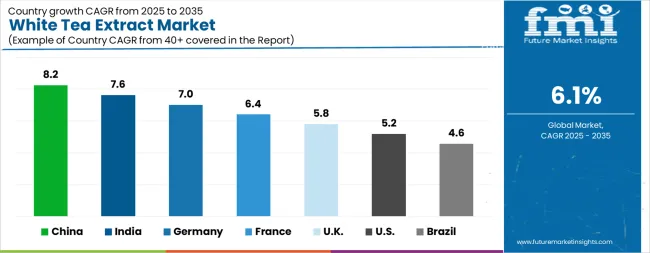
| Country | CAGR |
|---|---|
| China | 8.2% |
| India | 7.6% |
| Germany | 7.0% |
| France | 6.4% |
| UK | 5.8% |
| USA | 5.2% |
| Brazil | 4.6% |
The White Tea Extract Market is expected to register a CAGR of 6.1% during the forecast period, exhibiting varied country level momentum. China leads with the highest CAGR of 8.2%, followed by India at 7.6%. Developed markets such as Germany, France, and the UK continue to expand steadily, while the USA is likely to grow at consistent rates. Brazil posts the lowest CAGR at 4.6%, yet still underscores a broadly positive trajectory for the global White Tea Extract Market. In 2024, Germany held a dominant revenue in the Western Europe market and is expected to grow with a CAGR of 7.0%. The USA White Tea Extract Market is estimated to be valued at USD 509.8 million in 2025 and is anticipated to reach a valuation of USD 845.1 million by 2035. Sales are projected to rise at a CAGR of 5.2% over the forecast period between 2025 and 2035. While Japan and South Korea markets are estimated to be valued at USD 69.5 million and USD 46.3 million respectively in 2025.
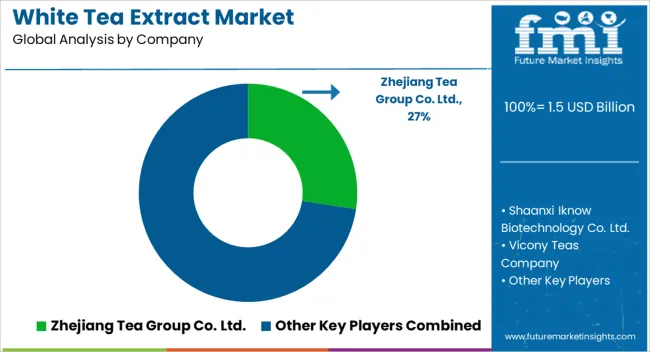
| Item | Value |
|---|---|
| Quantitative Units | USD 1.5 Billion |
| Application | Food And Beverage Industry, Health And Hygiene Products, Cosmetics, Biological Pesticides, and Animal Feed |
| Variety | Darjeeling, White Peony, Monkey Picked, and Silver Needle |
| Flavor | Honey, Fruity, Grassy, Vanilla, and Others |
| Regions Covered | North America, Europe, Asia-Pacific, Latin America, Middle East & Africa |
| Country Covered | United States, Canada, Germany, France, United Kingdom, China, Japan, India, Brazil, South Africa |
| Key Companies Profiled | Zhejiang Tea Group Co. Ltd., Shaanxi Iknow Biotechnology Co. Ltd., Vicony Teas Company, Changsha Botaniex Inc., Carrubba INC, Wollenhaupt, Lanzhou Waltlets Biotech Co. Ltd, Arihant Tea Company, and Solanki Tea Co. Private Limited |
The global white tea extract market is estimated to be valued at USD 1.5 billion in 2025.
The market size for the white tea extract market is projected to reach USD 2.7 billion by 2035.
The white tea extract market is expected to grow at a 6.1% CAGR between 2025 and 2035.
The key product types in white tea extract market are food and beverage industry, health and hygiene products, cosmetics, biological pesticides and animal feed.
In terms of variety, darjeeling segment to command 30.0% share in the white tea extract market in 2025.






Our Research Products

The "Full Research Suite" delivers actionable market intel, deep dives on markets or technologies, so clients act faster, cut risk, and unlock growth.

The Leaderboard benchmarks and ranks top vendors, classifying them as Established Leaders, Leading Challengers, or Disruptors & Challengers.

Locates where complements amplify value and substitutes erode it, forecasting net impact by horizon

We deliver granular, decision-grade intel: market sizing, 5-year forecasts, pricing, adoption, usage, revenue, and operational KPIs—plus competitor tracking, regulation, and value chains—across 60 countries broadly.

Spot the shifts before they hit your P&L. We track inflection points, adoption curves, pricing moves, and ecosystem plays to show where demand is heading, why it is changing, and what to do next across high-growth markets and disruptive tech

Real-time reads of user behavior. We track shifting priorities, perceptions of today’s and next-gen services, and provider experience, then pace how fast tech moves from trial to adoption, blending buyer, consumer, and channel inputs with social signals (#WhySwitch, #UX).

Partner with our analyst team to build a custom report designed around your business priorities. From analysing market trends to assessing competitors or crafting bespoke datasets, we tailor insights to your needs.
Supplier Intelligence
Discovery & Profiling
Capacity & Footprint
Performance & Risk
Compliance & Governance
Commercial Readiness
Who Supplies Whom
Scorecards & Shortlists
Playbooks & Docs
Category Intelligence
Definition & Scope
Demand & Use Cases
Cost Drivers
Market Structure
Supply Chain Map
Trade & Policy
Operating Norms
Deliverables
Buyer Intelligence
Account Basics
Spend & Scope
Procurement Model
Vendor Requirements
Terms & Policies
Entry Strategy
Pain Points & Triggers
Outputs
Pricing Analysis
Benchmarks
Trends
Should-Cost
Indexation
Landed Cost
Commercial Terms
Deliverables
Brand Analysis
Positioning & Value Prop
Share & Presence
Customer Evidence
Go-to-Market
Digital & Reputation
Compliance & Trust
KPIs & Gaps
Outputs
Full Research Suite comprises of:
Market outlook & trends analysis
Interviews & case studies
Strategic recommendations
Vendor profiles & capabilities analysis
5-year forecasts
8 regions and 60+ country-level data splits
Market segment data splits
12 months of continuous data updates
DELIVERED AS:
PDF EXCEL ONLINE
White Top Testliner Market Size and Share Forecast Outlook 2025 to 2035
White Inorganic Pigment Market Size and Share Forecast Outlook 2025 to 2035
White Matter Injury Treatment Market Size and Share Forecast Outlook 2025 to 2035
Whitening Gold Peptide Complex Market Size and Share Forecast Outlook 2025 to 2035
White Wheat Malt Market Size and Share Forecast Outlook 2025 to 2035
White Box Server Market Size and Share Forecast Outlook 2025 to 2035
White Charcoal Powder Market Size, Growth, and Forecast for 2025 to 2035
White Sneakers Market Insights - Size & Forecast 2025 to 2035
White Pepper Market Analysis by Product Type, Form, Application and Distribution Channel Through 2035
White Mineral Oil Market Analysis by Food, Pharmaceutical, Technical Through 2035
Leading Providers & Market Share in White Mushroom Industry
Competitive Overview of White Cement Market Share
Whiteness Meter Market
White Line Chipboard Market
White Sack Kraft Paper Market
White Rice Flour Market
White Mulberry Leaves Extract Market Growth - Product Type & Form Insights
TV White Space Spectrum Market Report - Growth & Forecast 2025 to 2035
Egg White Powder Market Size and Share Forecast Outlook 2025 to 2035
Egg White Cubes Market Size and Share Forecast Outlook 2025 to 2035

Thank you!
You will receive an email from our Business Development Manager. Please be sure to check your SPAM/JUNK folder too.
Chat With
MaRIA